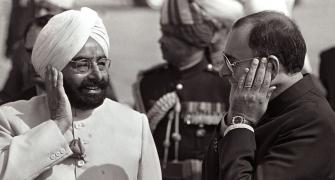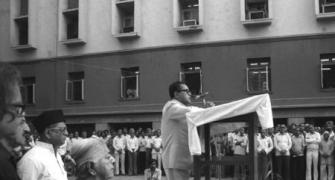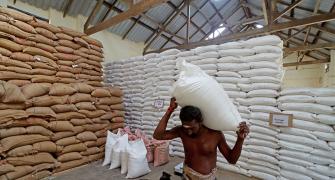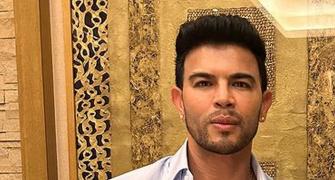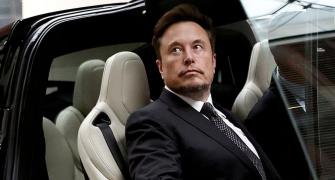Gianiji had crafted his moves with the meticulous planning of a chess grandmaster.
He did not know whether a checkmate was feasible, as his time was running out, but he wanted Rajiv Gandhi to smell the fear of loss.
A fascinating excerpt from K C Singh's The Indian President: An Insider's Account of the Zail Singh Years.

Senior Opposition leaders, particularly NTR (N T Rama Rao) and (Ramakrishna) Hegde, had been quietly urging the President that he should make a bid for a second term.
The logic of such a move for Gianiji was obvious. Rajiv Gandhi, having lost his moral sheen, was cornered and perhaps vulnerable.
If his official candidate was to lose, he would come under renewed pressure to resign.
Fearing the consequences of failure, the prime minister could accept, albeit reluctantly, a second term for Gianiji.
The fly in the ointment was Vice President (Ramaswamy) Venkataraman. He had acquired a reputation for efficiency and uprightness.
He had also worked assiduously as Rajya Sabha chairman to be helpful to Rajiv Gandhi all through the March-May period, when the Opposition had been baying for the Prime Minister's blood.
He was a smart political operator, as President Singh was soon to discover.
Gianiji had crafted his moves with the meticulous planning of a chess grandmaster. He did not know whether a checkmate was feasible, as his time was running out, but he wanted Rajiv Gandhi to smell the fear of loss.
It was a matter of restoring the President's honour and repaying the agony he had stoically endured.
Sometime thereafter, the President started de-emphasising the dismissal argument in his conversations with visitors.
He realised that it had been an excellent psychological prod, both to keep the prime minister off balance and to encourage fissures in the Congress.
Beyond that, he was fully cognisant of the reality that in any direct confrontation, he may be the one vanquished.
The initiative could pass to others, like the Supreme Court, or worse, the street.
Rajiv Gandhi would bring to bear the full power of the PMO and his government if the President took any step of questionable legality.
He may have been the Commander-in-Chief, but it was a title best left untested.

Two incidents demonstrate the dangers lurking in the background when relations between the President and the prime minister are unstable.
One occurred in the early part of Rajiv Gandhi's term. The President's Bodyguard had half-a-dozen armoured cars of World War II vintage.
They were sent periodically to the petrol pumps then situated on Sardar Patel Marg.
One day, an armoured car broke down and was temporarily abandoned off the road near the service station.
It happened on a day when some foreign dignitary was arriving, and the President and the prime minister had to take the same route to the airport to receive him.
(Then army chief) General (Krishnaswamy) Sundarji noticed the armoured car. Promptly, his aide reached the commandant of the President's Bodyguard enquiring why their armoured car was stationed on the prime minister's route.
They were reassured that it was an accidental breakdown. The worry in the army chief's mind seemed to be of the potential danger of the vehicle to the prime minister.

Similarly, in 1987, a senior Congressman, involved with sports bodies and a votary of presidential action against Rajiv Gandhi, had gone to Chandigarh.
In a tete-a-tete with Lieutenant General Prem Nath Hoon, GOC-in-chief of Western Command, he rashly queried how the army would react if the President dismissed the prime minister.
He came back and told me to tell the President that the army would not intervene on behalf of the prime minister.
I mentioned this to Gianiji, who was displeased with this kind of activism. He said it was not to be pursued further.
An important meeting took place with Vice President Venkataraman on 24 May (1987).
The vice president discussed the Presidential elections and bemoaned that Rajiv Gandhi had still not asked him to be the party candidate.
He added that if the generally accepted convention was not followed of selecting the incumbent vice president as the president, he would resign.
This opened an interesting possibility. If Rajiv Gandhi picked B Shankaranand for the Presidency and the vice president resigned in protest, it could start a churn against the official candidate.
That could improve the possibility of a rival candidate winning, especially if he had the near-unanimous support of the Opposition.
The President was continuing to assess all these possibilities. He had regained a good deal of moral authority in the last months of his presidency.
But events took an interesting turn over the next few days. Suddenly, the Congress announced Venkataraman's name as its candidate for President.
The name is not normally announced almost two months in advance of the election. Rajiv Gandhi could have done it for multiple reasons.

First, he must have been told about the vice president threatening to resign.
Government sleuths may have picked up his conversation with the president.
It is also possible that Venkataraman may have conveyed it to the prime minister's advisors, directly or subtly.
Gianiji felt that the vice president had deliberately aired those views to send a signal to the prime minister of an imminent convergence of interests between the two and thus a powerful aligning of forces.
Second, Rajiv Gandhi wanted to render the serving President a lame duck as early as possible.
He was unsure of what the President may do in his remaining days in office to enforce public accountability.
One thing is, however, certain. Rajiv Gandhi was compelled to back a credible candidate due to the fear that a less worthy individual may successfully get challenged by President Singh.
There were now only two paths remaining for the President. One was to await more revelations concerning the Bofors case and hope a smoking gun emerged.
But time was running out. The other option was to explore if sufficient support was available to challenge the official candidate of the Congress in the presidential election.

During this last phase, Chandraswami, the fortune-and power-seeking tantric, suddenly became very active on the political scene along with his close associate, Kailash Nath Aggarwal, popularly known as Mamaji.
Would there be a smoking gun? Mamaji absolutely insisted there was, and they would procure it.
Why was Chandraswami so proactive? That was left to be conjectured. His disciple, P V Narasimha Rao, had been sidelined in government and given the human resource development portfolio.
It did not occur to me at that stage that Chandraswami may have been using us to generate a bargaining position with Rajiv Gandhi.
Rao was made the minister for external affairs on 25 June 1988, a year after the Zail Singh Presidency ended.
I was told that Mamaji would return to India towards the end of May with actual banking proof of the huge sums credited to the accounts of Sonia Gandhi's family.
One evening in May, (then India Today journalist) Prabhu Chawla and I waited for the elusive Mamaji at my residence, but he did not turn up.
Finally, Mamaji did show up. He was a short, fair-complexioned man who oozed prosperity. There was a self-confident air about him. He was carrying a hard-shelled briefcase, typical of that period.
He opened it and out came a one-page hazy photocopy of what was purported to be Sonia Maino's account with an Italian bank.
There were figures of some large deposits, but it was either a forgery or so incomplete that it was inadmissible even in the journalistic court of Prabhu Chawla.
Mamaji then went on to display half-a-dozen black-and white pictures, about the size of a foolscap paper, taken at the funeral of Sonia Gandhi's father.
He wanted us to believe that some of the characters around Sonia's sister and brother-in-law were in the arms trade.
The pursuit of the smoking gun ended in a 'whimper' and not a 'bang', in T S Eliot's words, completely betraying our expectations.
Were scores being settled between rival arms dealers? Did Chandraswami have a political agenda, positioning himself, in case Rajiv Gandhi resigned or was dismissed? Was he playing his game on behalf of Narasimha Rao?
President Singh separately got one of his proteges from Andhra Pradesh, who had access to Narasimha Rao, to check out the minister's mind. Rao was unwilling to stand up and take sides.

By the end of May, it was clear that on the Bofors front no more leaks were likely to be available in the short period to the President.
Those who were strong votaries of the dismissal route were disappointed by the President's reluctance to act.
He was unwilling to be emotionally blackmailed into taking an extreme step unless a credible Congressman, with some support, was willing to publicly confront the prime minister.
Separately, more clinching evidence was required showing a trail of money to the prime minister, his family, or his associates.
By June, there was only one gambit available to the President. It was the Presidential election on 13 July.
The possibility of the President's bid for re-election had forced Rajiv Gandhi to endorse a strong and credible candidate, Vice President Venkataraman.
The President had a cynical assessment of his former colleagues in the Congress in general. He felt they had a herd mentality and would normally not abandon their leader.
When he asked his good friend and former Bihar chief minister Jagannath Misra how many MPs were in his group, the candid reply was that if he was in the Congress, then six or seven, but if he defied the Congress, then two or three.
The President then put the condition that he was willing to contest as a united Opposition candidate, even against Venkataraman, provided V P Singh proposed his name.
He sensed that V P Singh was unlikely to agree. But if senior Opposition leaders could convince him to do so, the President was ready for the contest.
He knew that V P Singh at that stage was seen by the public as the sole custodian of moral authority.
That did not happen, and the President settled, in cricketing terms, for a draw.
Excerpted from The Indian President: An Insider's Account of the Zail Singh Years by K C Singh, with the kind permission of the publishers, HarperCollins India.
Feature Presentation: Aslam Hunani/Rediff.com

